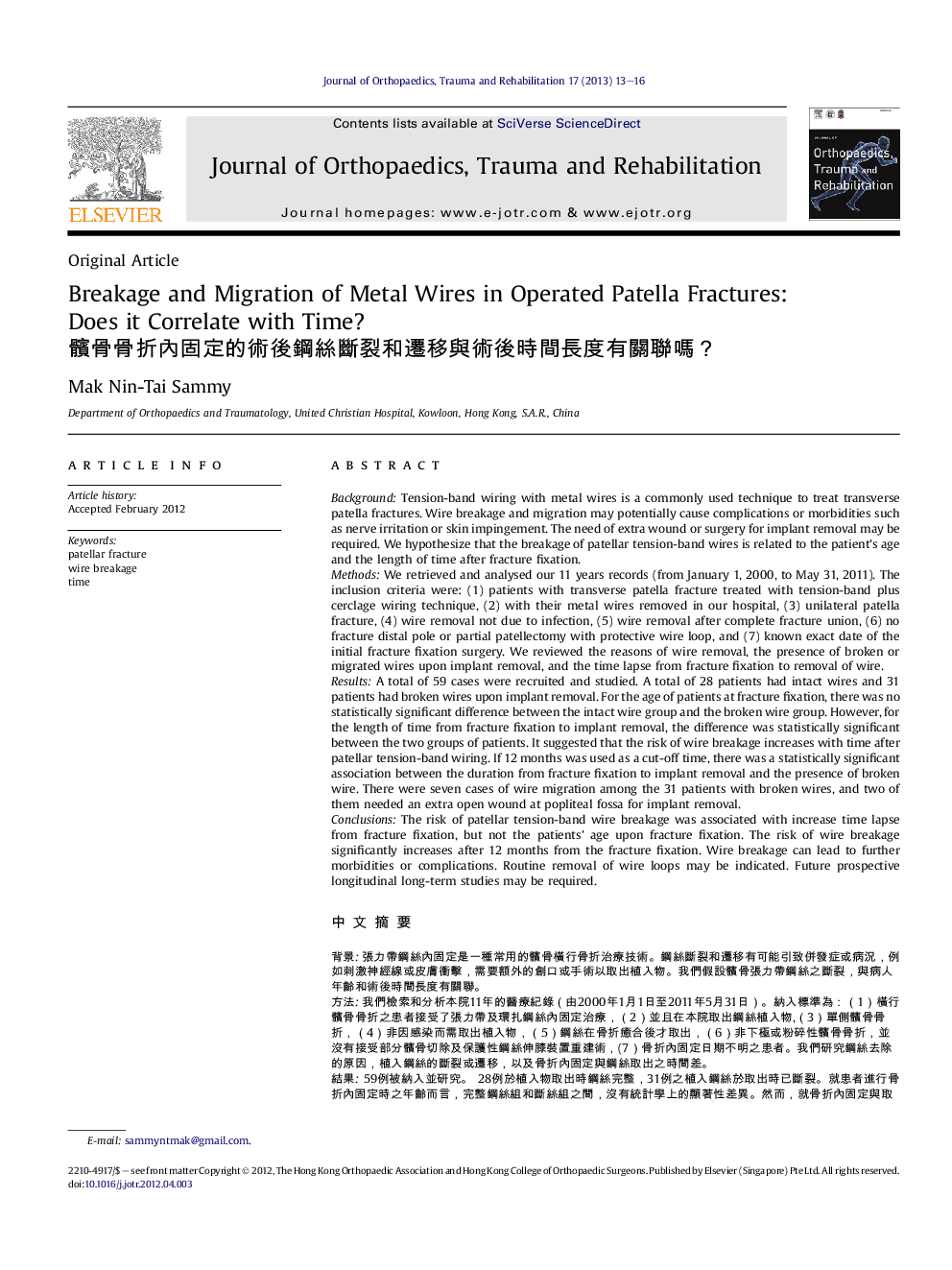| Article ID | Journal | Published Year | Pages | File Type |
|---|---|---|---|---|
| 4072656 | Journal of Orthopaedics, Trauma and Rehabilitation | 2013 | 4 Pages |
BackgroundTension-band wiring with metal wires is a commonly used technique to treat transverse patella fractures. Wire breakage and migration may potentially cause complications or morbidities such as nerve irritation or skin impingement. The need of extra wound or surgery for implant removal may be required. We hypothesize that the breakage of patellar tension-band wires is related to the patient's age and the length of time after fracture fixation.MethodsWe retrieved and analysed our 11 years records (from January 1, 2000, to May 31, 2011). The inclusion criteria were: (1) patients with transverse patella fracture treated with tension-band plus cerclage wiring technique, (2) with their metal wires removed in our hospital, (3) unilateral patella fracture, (4) wire removal not due to infection, (5) wire removal after complete fracture union, (6) no fracture distal pole or partial patellectomy with protective wire loop, and (7) known exact date of the initial fracture fixation surgery. We reviewed the reasons of wire removal, the presence of broken or migrated wires upon implant removal, and the time lapse from fracture fixation to removal of wire.ResultsA total of 59 cases were recruited and studied. A total of 28 patients had intact wires and 31 patients had broken wires upon implant removal. For the age of patients at fracture fixation, there was no statistically significant difference between the intact wire group and the broken wire group. However, for the length of time from fracture fixation to implant removal, the difference was statistically significant between the two groups of patients. It suggested that the risk of wire breakage increases with time after patellar tension-band wiring. If 12 months was used as a cut-off time, there was a statistically significant association between the duration from fracture fixation to implant removal and the presence of broken wire. There were seven cases of wire migration among the 31 patients with broken wires, and two of them needed an extra open wound at popliteal fossa for implant removal.ConclusionsThe risk of patellar tension-band wire breakage was associated with increase time lapse from fracture fixation, but not the patients' age upon fracture fixation. The risk of wire breakage significantly increases after 12 months from the fracture fixation. Wire breakage can lead to further morbidities or complications. Routine removal of wire loops may be indicated. Future prospective longitudinal long-term studies may be required.
中文摘要背景張力帶鋼絲內固定是一種常用的髕骨橫行骨折治療技術。鋼絲斷裂和遷移有可能引致併發症或病況,例如刺激神經線或皮膚衝擊,需要額外的創口或手術以取出植入物。我們假設髕骨張力帶鋼絲之斷裂,與病人年齡和術後時間長度有關聯。方法我們檢索和分析本院11年的醫療紀錄(由2000年1月1日至2011年5月31日)。納入標準為:(1)橫行髕骨骨折之患者接受了張力帶及環扎鋼絲內固定治療,(2)並且在本院取出鋼絲植入物,(3)單側髕骨骨折,(4)非因感染而需取出植入物,(5)鋼絲在骨折癒合後才取出,(6)非下極或粉碎性髕骨骨折,並沒有接受部分髕骨切除及保護性鋼絲伸膝裝置重建術,(7)骨折內固定日期不明之患者。我們研究鋼絲去除的原因,植入鋼絲的斷裂或遷移,以及骨折內固定與鋼絲取出之時間差。結果59例被納入並研究。 28例於植入物取出時鋼絲完整,31例之植入鋼絲於取出時已斷裂。就患者進行骨折內固定時之年齡而言,完整鋼絲組和斷絲組之間,沒有統計學上的顯著性差異。然而,就骨折內固定與取出鋼絲之時間差而言,兩組患者卻有統計學上的顯著性差異。這表明,鋼絲斷裂的風險隨著術後的時間長度而增加。如果以12個月為分界,骨折內固定到取出鋼絲之時間差與鋼絲斷裂之發生有統計學上的關聯。在斷絲組的31例中,有7例鋼絲遷移,其中2人需要額以外的膕窩傷口取出植入物。結論髕骨張力帶鋼絲斷裂的風險與術後時間長度有關聯 ,但與患者進行骨折內固定時之年齡沒有關係。鋼絲斷裂的風險在骨折內固定的12個月後顯著增加。鋼絲斷裂可導致另外的病況或併發症。慣常性取出植入物可能是必須的。我們可能需要作進一步的長期前瞻性研究。
